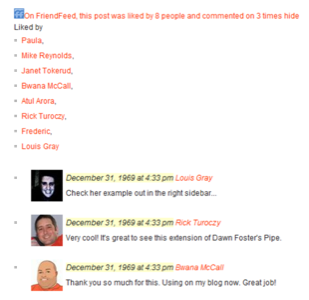Over the weekend, this post on Paul Graham’s blog got a lot of attention. The title was “How to Disagree,” and it focused on the different types of negative, or disagreeing, blog comments. As Matthew Greensmith of Geek News Central called it, it was “a true geek masterpiece.” Paul listed all the different types of disagreements (as related to blog comments) on a hierarchical scale from DH0 (name-calling) to DH6 (refuting the central point). And while the varying levels of disagreement detailed in the post were right on target, the question that came to mind is “what about agreement?” Why is it that positive reactions to blog posts are so much harder to come by? And how can bloggers get more of them?

Why Are More Comments Negative?
In Paul’s post, he notes that “Agreeing tends to motivate people less than disagreeing. And when you agree there’s less to say. You could expand on something the author said, but he has probably already explored the most interesting implications.”
It’s true. When you’re agreeing with an author of a blog post, it just seems kind of silly to take the time to write out a comment that simply states: “I agree.” So instead, the agreement or the liking of the post stays off-record. This means that even on a more universally well thought of post, the comments will often be the domain of the discordant few. This doesn’t give a fair representation of the thoughts and reactions of the readers and, therefore, doesn’t provide any true insight into the way the issue is perceived. It could be that 90% of the readers think the author is correct in their opinion, but only the 10% who feel differently have made their voices heard.
Additionally, as those of you who are also bloggers know, it can be disheartening for authors to read through blog comments to only find comments consisting of “well, actually…,” “this is old news,” and the equivalent of “that’s so lame!” filling up the commentary section. Perhaps the post was lame, but then again, it could be that those who enjoyed it haven’t taken time to respond.
Commentary and opinions don’t have to be pigeon-holed as being in agreement or disagreement, though. Yes, some opinions could be in favor of or against the post, but others could be undecided, confused, or neutral. Unfortunately, it seems that readers with those sorts opinions just move on, not bothering to post anything anywhere until they happen across a blog that sufficiently riles them up over an issue.
Where the Positive Reactions Are
Maybe it’s just human nature to only be inspired to opine when you’re vehemently against something.
So for generating positive reactions, a service like FriendFeed(sorry in advance to those of you who are sick of the hype) fills a void. In FriendFeed, a simple click allows you to “like” a blog post. You don’t have to comment. You aren’t whisked away off-site like you are when clicking a Digg button. It’s just one click in your stream of content. You see a smiley face. The blog author sees a smiley face. It’s nice.

In fact, in this respect, FriendFeed is the new Digg. Yes, I said it.
Whereas at one time, digging a post meant “this is interesting, I enjoyed it,” these days, digging is a serious business. Writing for Digg, the logistics of getting to the front page, befriending the elite diggers, the potential for buries…it has all made Digg an interesting and important ecosystem to generate traffic and interest for a web site, but soon, it will no longer the best way to see the true popularity of post. Instead, highly dugg stories are more like a combination of various forces, metrics, timing, and luck.
Instead, it’s the smiley faces of FriendFeed that will be the metric of the future for judging popularity of a blog post. Especially since the FriendFeed API has introduced a way for a WordPress/FriendFeed plugin to exist. All we need now is a universal plugin that’s tweaked so as to let you “like” the post on FriendFeed while still on the blog’s web site itself. Then we’ll really be in business.
Example of the FriendFeed plugin in action

For what it’s worth, the plugin also addresses earlier concerns that the conversation has left the blogosphere. And with blog commenting system, Disqus, being able to integrate back into FriendFeed, it all comes full circle. But that’s another post.
More Difficult – Continuing the Conversation via Blog Comments
While FriendFeed makes it easy for people to mark their enjoyment of a blog post, having people comment on the blog with something useful, constructive, or positive is far more difficult.
Referring back the Geek News post, the author writes, “There are loosely 3 groups in increasing order of prevalence: those that want to add something to the conversation (constructors), those that have a strong contrary opinion (objectors) and those that just want attention (detractors).”
It’s easy to get detractors. Just throw up an inflammatory post, make some wild claim, or post something that’s knowingly inaccurate. Comments ensue.
Objectors aren’t so bad, either. They sit on the other side of the fence and offer a differing viewpoint. Sometimes, an objector can also be a constructor and add to the post. I think of this example, where our “Comment of the Day” winner, Jerome, was so convinced about Google Docs’ brilliance that he took the time to give numerous examples of what the service can do, which led to a discovery of a feature that many of us were unaware of: GoogleLookUp. So objectors can definitely add to the blog.
Other times, the objectors fall somewhere else on the “Paul Graham Scale of Disagreement,” desperate to share their opinion, but going about it in a less convincing way (see DH3 and below). While sometimes the name-calling (DH0) can be humorous (yes, I’m guilty of have voted up the occasional hilarious Digg comment), more often than not it’s a detractor to the conversation.
So how can you entice the elusive constructor to add their thoughts to a blog post? To get this sort of blog commenter, you have to first attract a quality readership to your site. This is more difficult. Articles have to well-researched, well-written, intelligent, and insightful. For a blog to provide regular posts of high quality is difficult, but it can be done. And once you have quality readers – those who thoughtfully read the article, think about what they want to say, and then compose their thoughts in a way that creates a valuable addition to the original post – you have a conversation of merit and something worth reading.
And shouldn’t that be the true goal of blogging? Intelligent conversation? As a blogger, the focus should be on starting that conversation; for readers, it should be adding to it. Blogger and reader don’t always have to agree with each other, but being able to at least constructively debate the issue brings something to the table that straightforward reporting does not.
In this age of information overload, constructive conversations will win out in the long run. You’ll find the best conversations through your network of friends – shared in Google Reader, posted on FriendFeed, or maybe even the old-fashioned way (email!). As you narrow your focus to this unique and personal slice of the web, you’ll remember why you love blog reading in the first place – not to get Google Reader to stop saying “1000+” – but to join a conversation, add value to a discussion, find like-minded people, debate an issue, learn something new, and maybe even better understand yourself and the world.










